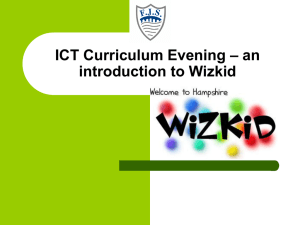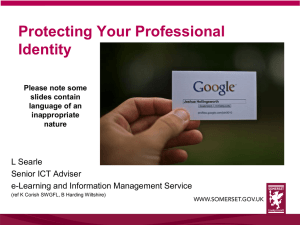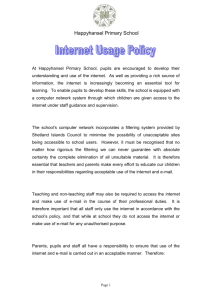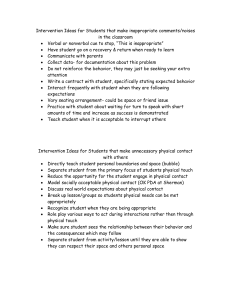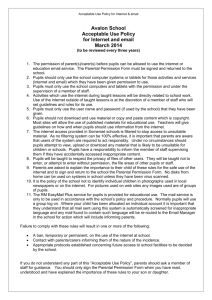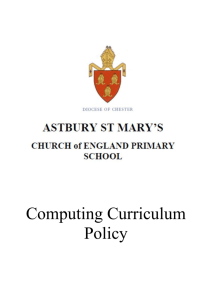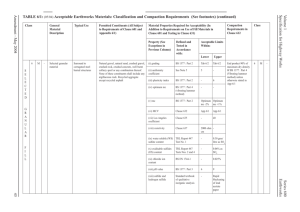Internet-Saftey-Policy---Bunscoil-an-Iir.doc
advertisement
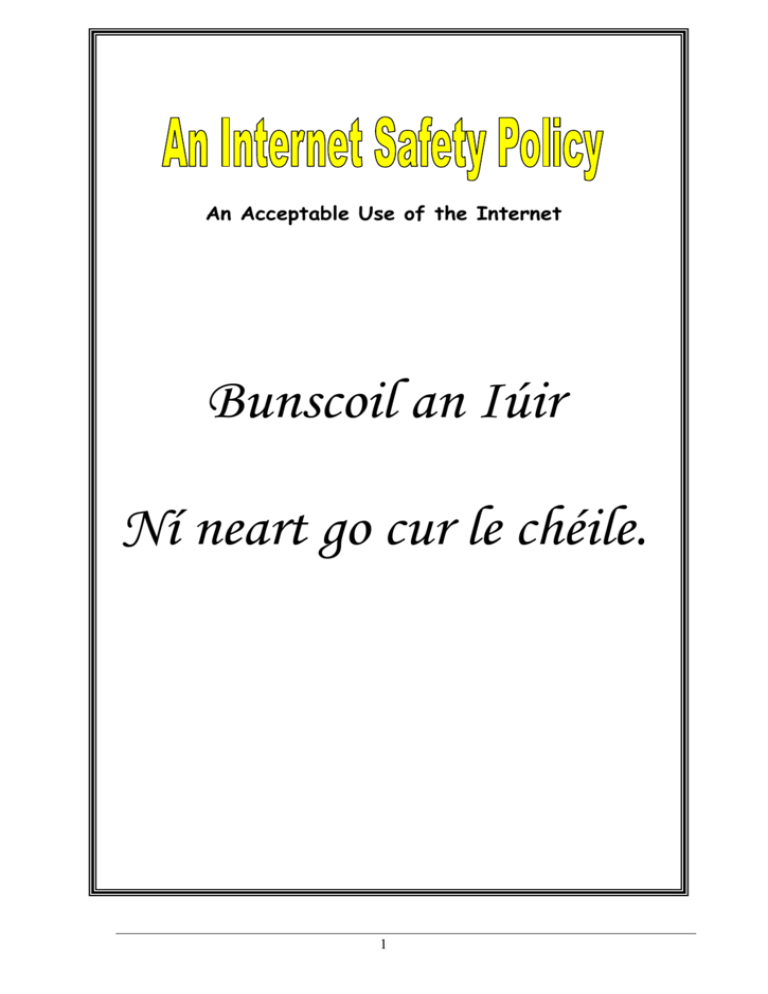
An Acceptable Use of the Internet Bunscoil an Iúir Ní neart go cur le chéile. 1 What is the Internet? The Internet is a huge network of computers making a worldwide community. It is a way of connecting computers together so that people using them can: talk to each other, send and receive messages, obtain information and resources, publish information, buy and sell things and have fun. Its most frequently used facilities include: The World Wide Web (WWW) The World Wide Web (WWW) or Web provides easy access to the vast quantity of information and resources available on the Internet and is the facility which people use to “surf” for information. It is made up of millions of screens or pages of information. The collection of pages created by one individual or organisation is known as a website. Each page can include text sound, images, animation and video and has its own unique address. E-Mail E-mail allows users to send and receive written messages. Chat Rooms Chat rooms allow a number of people to “meet” on the Internet. It is similar to having a telephone conversation with a number of people at one time except that the participants type instead of talk. The Internet is often described as being like a vast city. It is an exciting place with a great variety of places to visit. There are shops, entertainment areas, educational areas and people to meet. But it also contains dangers. There are areas that we do not want to go to and that we certainly would not want children to visit. 2 How Valuable is the Internet in Education? . “95% of teachers believe that the use of technology is raising standards in schools and colleges“. BECTA – RAISING STANDARDS - Leading next generation learning Jan 2010 The Internet is a unique and exciting resource. It brings the world into the classroom by giving children access to a global network of educational resources. It gives children opportunities to locate, retrieve and exchange information. It encourages the development of ICT skills that are vital to lifelong learning. Using technology can directly affect standards. It supports good practice in teaching and learning. It can also help with managing data held about learners and so enable more informed decision making. It takes learning beyond the classroom. 3 It allows access to stores of information that might otherwise be unavailable in school. Internet Technology enables learners to: • join in a wider range of learning experiences • learn at a pace and time to suit them • benefit from flexible and new teaching approaches • access information and learning resources safely and securely • involve their peers, parents and carers in their education • extend learning beyond the classroom. It provides up-to-date information. It is a fast and efficient way of communicating and retrieving information. It encourages independent learning. Children enjoy using it. It is part of their life experience. It is “cool”. The Internet is increasingly forming part of our work, home, social and leisure activities. There is no doubt that the use of the Internet is an essential skill for children as they grow up in the modern world. 4 What are the Dangers? The Internet is an open communications channel, available to all. Anyone can send messages, discuss ideas and publish materials with little restriction. This brings young people into contact with people from all sectors of society and with a wide variety of materials some of which could be unsuitable. Key Concerns are: Potential Contact Children may come into contact with someone on-line who may wish to harm them. Some adults use chat rooms or e-mail to communicate with children for inappropriate reasons Children need to be taught: That people are not always who they say they are. That “Stranger Danger” applies to the people they encounter through the Internet. That they should never give out personal details or That they should never meet alone anyone contacted via the Internet Inappropriate Content Through the Internet there are unsuitable materials in many varieties. Anyone can post material on the Internet. Some material is published for an adult audience and is unsuitable for children e.g. materials with a sexual content. Materials may express extreme views. E.g. some use the web to publish information on weapons, crime and racism which would be restricted elsewhere. Materials may contain misleading and inaccurate information. E.g. some use the web to promote activities which are harmful such as anorexia or bulimia. Children need to be taught: That information on the Internet is not always accurate or true. To question the source of information. How to respond to unsuitable materials or requests and that they should tell a teacher/adult immediately. 5 Excessive Commercialism The Internet is a powerful vehicle for advertising. In visiting websites children have easy access to advertising which is very persuasive. Children should be taught: Not to fill out forms with a lot of personal details. Not to use an adult’s credit card number to order online products. If children are to use the Internet in places other than at school e.g. – libraries, clubs and at home, they need to be educated about how to behave on-line and to discuss problems. There are no totally effective solutions to problems of Internet safety. Teachers, pupils and parents must be vigilant. 6 Steps We Take to Protect Children In Bunscoil an Iuir. Use of a Filtered Service Access to the Internet is provided through a filtered service. All access is provided through the C2k managed service which is designed to filter out unsuitable material. Supervision No filtering service is 100% effective, therefore all children’s use of the Internet is supervised by an adult at all times. Planned Activities Use of the Internet is a planned activity. Aimless ‘surfing’ is not allowed. Children are taught to use the Internet in response to a need e.g. a question which has arisen from work in class. Restrictions on E-mail Children are not given individual web-based e-mail addresses. In some instances children may have access to a group e-mail address to communicate with other children, perhaps in another school as part of a particular project. Messages sent and received in this way are supervised by the teacher at all times. Use of Learning NI Learning NI is a protected, secure online community designed specifically for children. It is fully mediated at all times to ensure children’s safety. Internet Safety Rules Children are taught to be Internet Wise. Children are made aware of Internet Safety Rules and are encouraged to discuss how to cope if they come across inappropriate material. 7 Points for Teachers to Consider Internet use should be planned, task orientated and educational within a regulated and managed environment Supervision is the key strategy. Children should have a teacher or classroom assistant present when using the Internet. Computers should be positioned so that it is possible for adults to see materials on screen. Children should know why they are using the Internet. Teach children to use the Internet in response to a need. E.g. to answer a question which has arisen from work in class. Search engines (Yahoo/Google) require careful use and planning/supervision. Children can be bombarded with information and yet fail to find the material they need. Teachers should select the search engine and topic and discuss sensible search words which have been tried out beforehand. Children do not need thousands of website addresses. A small appropriate choice is much more effective. ‘Favourites’ is a useful way to present this choice. Recommended sites should always be previewed and revisited to be checked out. Individual e-mail addresses may not be considered appropriate for children. Class or project e-mail addresses may be used. All incoming and outgoing mail should be checked. Discuss with pupils the rules for responsible Internet use. It is not enough to protect children from materials; we must teach them to become Internet Wise. Children need to learn to recognise and avoid the risks. Children need to know what to do if they come across inappropriate material or if they are approached by a stranger. Be informed – read about e-safety e.g. – Becta materials http://schools.becta.org.uk Discuss Internet Safety with colleagues and as a staff. 8 Points for Parents to Consider It is important to promote Internet Safety in the home and to monitor Internet use. Keep the computer in a communal area of the home. Ask children how the computer works. Monitor on-line time and be aware of excessive hours spent on the Internet. Complete the following E-Safety quiz: http://www.nextgenerationlearning.org.uk/AboutUs/E-SafetyQuiz/ Take an interest in what children are doing. Discuss with the children what they are seeing and using on the Internet. Advise children to take care and to use the Internet in a sensible and responsible manner. Know the SMART tips. Discuss the fact that there are websites which are unsuitable. Discuss how children should respond to unsuitable materials or requests. Remind children never to give out personal information on the Internet. 9 Remind children that people on line may not be who they say they are. Be vigilant. Ensure that children do not arrange to meet someone they meet on line. Be aware that children may be using the Internet in places other than in their own home or at school e.g. through their mobile phone. Filtering for the Home Computer – Parents may wish to invest in security software for their children’s computers. Some of this software works by monitoring all Internet activity for trigger words. There are many types of security software available. Examples include: Net Nanny, www.netnanny.com Surfwatch www.safesurf.com Mobile Phones Be aware of the safety issues regarding mobile phones. Increasingly these have Internet access. Encourage children to talk about how they use mobile phones. Remind children not to give mobile numbers to strangers and people they do not know very well. Talk about responsible use of text messaging/images etc. 10 Points for Children to Consider Follow These SMART TIPS S Secret - Always keep your name, address, mobile phone number and password private – it’s like giving out the keys to your home! M Meeting someone you have contacted in cyberspace can be dangerous. Only do so with your parent’s/carer’s permission, and then when they can be present. A Accepting e-mails or opening files from people you don’t really know or trust can get you into trouble – they may contain viruses or nasty messages. R T Remember someone on-line may be lying and not be who they say they are. Stick to the public areas in chat rooms and if you feel uncomfortable simply get out of there! Tell your parent or carer if someone or something makes you feel uncomfortable or worried. SMART Tips from: – Helping your parents be cool about the Internet, produced by: Northern Area Child Protection Committees 11 An Acceptable Use of the Internet Children should know that they are responsible for making an Acceptable Use of the Internet. They must discuss and agree rules for this Acceptable Use. Parents are also asked to be aware of the code of Acceptable Use and confirm that their children will follow these rules. On the network, I will only use my own login username and password. I will not look at, change or delete other people’s work/files. I will ask permission before entering any website, unless my teacher has already approved that site. I will only send e-mail which my teacher has approved. I will make sure that the messages I send are polite and sensible. When sending e-mail I will not give my name, address or phone number or arrange to meet anyone. I understand that I am not allowed to enter Internet Chat Rooms while using school computers. If I see anything I am unhappy with or I receive messages I do not like, I will tell a teacher immediately. I understand that if I deliberately break these rules I could be stopped from using the Internet. 12 A School Website Currently plans are under way for the construction of a website for Bunscoil an Iúir. When this site is operational, the following guidelines will apply:- Children will only be referred to by their first names. Any images of children will not be labelled with their name. Children and teachers will not reveal their personal details, home addresses or telephone numbers on the website. Children will not have individual e-mail addresses. Website links selected by teachers may be put on the website for pupils to access outside of school – sites will be previewed and checked regularly. Parents’/Carers’ permission will be sought to publish pupils work and/or photographs. These will only be published subject to the strict safeguards above. 13 All reasonable and appropriate steps have been taken to protect pupils. The school recognises that despite employing safety procedures, in some circumstances, the Internet may give children access to undesirable information or images. Children are regularly reminded that should they encounter inappropriate material on line they must immediately Leave that website Inform an adult Should a child or teacher encounter unsuitable material through using the NINE Connect service, this will be reported to C2k via the C2k helpdesk number. Policy Review Internet technology and school use of resources will develop and change with time. It is our intention to revise and up-date our Internet Safety Policy as appropriate and where necessary. 14 Guidance Material on Internet Safety Helping children to stay safe online includes awareness of e.g: What to do if they find inappropriate or unsuitable materials. Cyber bullying. Social Networking risks and protecting privacy. The websites below are designed to help children understand how to safeguard themselves and others. http://www.becta.org.uk/ http://www.nextgenerationlearning.org.uk/AboutUs/E-Safety-Quiz/ www.ceop.gov.uk www.thinkuknow.co.uk www.bbc.co.uk/cbbc/help/web/staysafe www.mundesleyjuniorschool.com/SchoolFolders/e-safety.shtml http://old.kidsmart.org.uk/yp/smart/default.aspx www.bullying.co.uk/index.php/young-people/cyberbullying/ Know it all for Primary Schools is a resource for primary teachers dealing with the main issues of e-safety. View it at: www.childnet-int.org/kia/primary Examples of safety rules for children are also available from: http://www.kented.org.uk/ngfl/policy 15
